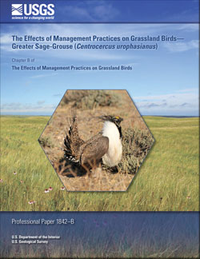The Effects of Management Practices on Grassland Birds—Greater Sage-Grouse (Centrocercus urophasianus)
Links
- Document: Report (2.08 MB pdf)
- Larger Work: This publication is Chapter B of The effects of management practices on grassland birds
- Download citation as: RIS | Dublin Core
Abstract
Keys to Greater Sage-Grouse (Centrocercus urophasianus) management are maintenance of expansive stands of sagebrush (Artemisia species [spp.]), especially varieties of big sagebrush (Artemisia tridentata) with abundant forbs in the understory, particularly during spring; undisturbed and somewhat open sites for leks; and healthy perennial grass and forb stands intermixed with sagebrush for brood rearing. Within suitable habitats, areas should have 15–25 percent canopy cover of sagebrush 30–80 centimeters (cm) tall for nesting and 10–25 percent canopy cover 40–80 cm tall for brood rearing. In winter habitats, shrubs should be exposed 25–35 cm above snow and have 10–30 percent canopy cover exposed above snow. In nesting and brood-rearing habitats, the understory should have at least 15 percent cover of grasses and at least 10 percent cover of forbs greater than or equal to 18 cm tall. Greater Sage-Grouse have been reported to use habitats with 5–110 cm average vegetation height, 5–160 cm visual obstruction reading, 3–51 percent grass cover, 3–20 percent forb cover, 3–69 percent shrub cover, 7–63 percent sagebrush cover, 14–51 percent bare ground, and 0–18 percent litter cover. Unless otherwise noted, this account refers to habitat requirements and environmental factors affecting Greater Sage-Grouse but not Gunnison Sage-Grouse (Centrocercus minimus). Habitats used by Gunnison Sage-Grouse are generally similar to habitats used by Greater Sage-Grouse, but some differences have been reported. The Greater Sage-Grouse is a game bird and is hunted throughout most of its current range. This account does not address harvest or its effects on populations; rather, this account focuses on the effects of habitat management.
Suggested Citation
Rowland, M.M., 2019, The effects of management practices on grassland birds—Greater Sage-Grouse (Centrocercus urophasianus), chap. B of Johnson, D.H., Igl, L.D., Shaffer, J.A., and DeLong, J.P., eds., The effects of management practices on grassland birds: U.S. Geological Survey Professional Paper 1842, 50 p., https://doi.org/10.3133/pp1842B.
ISSN: 2330-7102 (online)
Table of Contents
- Acknowledgments
- Capsule Statement
- Breeding Range
- Suitable Habitat
- Area Requirements and Landscape Associations
- Brood Parasitism by Cowbirds and Other Species
- Breeding-Season Phenology and Site Fidelity
- Species’ Response to Management
- Management Recommendations from the Literature
- References
| Publication type | Report |
|---|---|
| Publication Subtype | USGS Numbered Series |
| Title | The effects of management practices on grassland birds—Greater Sage-Grouse (Centrocercus urophasianus) |
| Series title | Professional Paper |
| Series number | 1842 |
| Chapter | B |
| DOI | 10.3133/pp1842B |
| Publication Date | October 07, 2019 |
| Year Published | 2019 |
| Language | English |
| Publisher | U.S. Geological Survey |
| Publisher location | Reston, VA |
| Contributing office(s) | Northern Prairie Wildlife Research Center |
| Description | v, 50 p. |
| Online Only (Y/N) | Y |
| Additional Online Files (Y/N) | N |


